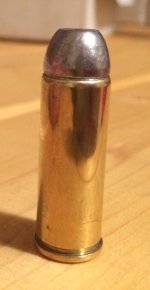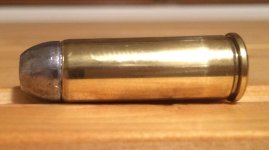Ike Clanton
New member
Hello! First post ever here however I know this topic is a dead horse. I've learned a lot through internet searches however. I test fired my first batch of 45 colt and all went well however I put one round in the chamber that I didn't fire during the course of 10 rounds. The crimp wasn't tight enough because the bullet pulled slightly from the case. Then I realized i could physically push the bullet into the case with my fingers until it hit the top of the cannelure groove. I then tightened the crimp to the point I couldn't physically push it into the case with my hands.
I just wanna know if it looks like too much crimp. Load is 250 gr LNFP 9.1 GR CFE pistol. Chronographed at 937fps in Ruger BH 5.5. And yes I've worked this load up from 8.8 GR just not in my own press.
I just wanna know if it looks like too much crimp. Load is 250 gr LNFP 9.1 GR CFE pistol. Chronographed at 937fps in Ruger BH 5.5. And yes I've worked this load up from 8.8 GR just not in my own press.


